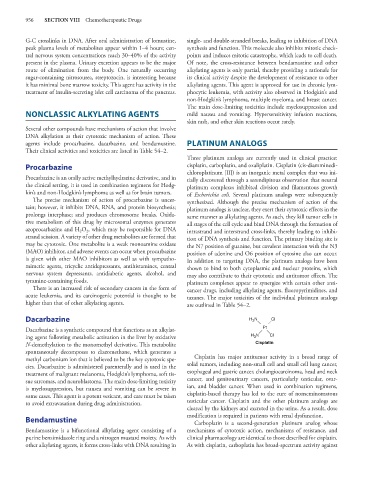Page 970 - Basic _ Clinical Pharmacology ( PDFDrive )
P. 970
956 SECTION VIII Chemotherapeutic Drugs
G-C crosslinks in DNA. After oral administration of lomustine, single- and double-stranded breaks, leading to inhibition of DNA
peak plasma levels of metabolites appear within 1–4 hours; cen- synthesis and function. This molecule also inhibits mitotic check-
tral nervous system concentrations reach 30–40% of the activity points and induces mitotic catastrophe, which leads to cell death.
present in the plasma. Urinary excretion appears to be the major Of note, the cross-resistance between bendamustine and other
route of elimination from the body. One naturally occurring alkylating agents is only partial, thereby providing a rationale for
sugar-containing nitrosourea, streptozocin, is interesting because its clinical activity despite the development of resistance to other
it has minimal bone marrow toxicity. This agent has activity in the alkylating agents. This agent is approved for use in chronic lym-
treatment of insulin-secreting islet cell carcinoma of the pancreas. phocytic leukemia, with activity also observed in Hodgkin’s and
non-Hodgkin’s lymphoma, multiple myeloma, and breast cancer.
The main dose-limiting toxicities include myelosuppression and
NONCLASSIC ALKYLATING AGENTS mild nausea and vomiting. Hypersensitivity infusion reactions,
skin rash, and other skin reactions occur rarely.
Several other compounds have mechanisms of action that involve
DNA alkylation as their cytotoxic mechanism of action. These
agents include procarbazine, dacarbazine, and bendamustine. PLATINUM ANALOGS
Their clinical activities and toxicities are listed in Table 54–2.
Three platinum analogs are currently used in clinical practice:
Procarbazine cisplatin, carboplatin, and oxaliplatin. Cisplatin (cis-diamminedi-
chloroplatinum [II]) is an inorganic metal complex that was ini-
Procarbazine is an orally active methylhydrazine derivative, and in tially discovered through a serendipitous observation that neutral
the clinical setting, it is used in combination regimens for Hodg- platinum complexes inhibited division and filamentous growth
kin’s and non-Hodgkin’s lymphoma as well as for brain tumors. of Escherichia coli. Several platinum analogs were subsequently
The precise mechanism of action of procarbazine is uncer- synthesized. Although the precise mechanism of action of the
tain; however, it inhibits DNA, RNA, and protein biosynthesis; platinum analogs is unclear, they exert their cytotoxic effects in the
prolongs interphase; and produces chromosome breaks. Oxida- same manner as alkylating agents. As such, they kill tumor cells in
tive metabolism of this drug by microsomal enzymes generates all stages of the cell cycle and bind DNA through the formation of
azoprocarbazine and H O , which may be responsible for DNA intrastrand and interstrand cross-links, thereby leading to inhibi-
2
2
strand scission. A variety of other drug metabolites are formed that tion of DNA synthesis and function. The primary binding site is
may be cytotoxic. One metabolite is a weak monoamine oxidase the N7 position of guanine, but covalent interaction with the N3
(MAO) inhibitor, and adverse events can occur when procarbazine position of adenine and O6 position of cytosine also can occur.
is given with other MAO inhibitors as well as with sympatho- In addition to targeting DNA, the platinum analogs have been
mimetic agents, tricyclic antidepressants, antihistamines, central shown to bind to both cytoplasmic and nuclear proteins, which
nervous system depressants, antidiabetic agents, alcohol, and may also contribute to their cytotoxic and antitumor effects. The
tyramine-containing foods. platinum complexes appear to synergize with certain other anti-
There is an increased risk of secondary cancers in the form of cancer drugs, including alkylating agents, fluoropyrimidines, and
acute leukemia, and its carcinogenic potential is thought to be taxanes. The major toxicities of the individual platinum analogs
higher than that of other alkylating agents. are outlined in Table 54–2.
Dacarbazine H 3 N Cl
Dacarbazine is a synthetic compound that functions as an alkylat- Pt
ing agent following metabolic activation in the liver by oxidative H 3 N Cl
N-demethylation to the monomethyl derivative. This metabolite Cisplatin
spontaneously decomposes to diazomethane, which generates a
methyl carbonium ion that is believed to be the key cytotoxic spe- Cisplatin has major antitumor activity in a broad range of
cies. Dacarbazine is administered parenterally and is used in the solid tumors, including non-small cell and small cell lung cancer,
treatment of malignant melanoma, Hodgkin’s lymphoma, soft tis- esophageal and gastric cancer, cholangiocarcinoma, head and neck
sue sarcomas, and neuroblastoma. The main dose-limiting toxicity cancer, and genitourinary cancers, particularly testicular, ovar-
is myelosuppression, but nausea and vomiting can be severe in ian, and bladder cancer. When used in combination regimens,
some cases. This agent is a potent vesicant, and care must be taken cisplatin-based therapy has led to the cure of nonseminomatous
to avoid extravasation during drug administration. testicular cancer. Cisplatin and the other platinum analogs are
cleared by the kidneys and excreted in the urine. As a result, dose
Bendamustine modification is required in patients with renal dysfunction.
Carboplatin is a second-generation platinum analog whose
Bendamustine is a bifunctional alkylating agent consisting of a mechanisms of cytotoxic action, mechanisms of resistance, and
purine benzimidazole ring and a nitrogen mustard moiety. As with clinical pharmacology are identical to those described for cisplatin.
other alkylating agents, it forms cross-links with DNA resulting in As with cisplatin, carboplatin has broad-spectrum activity against

